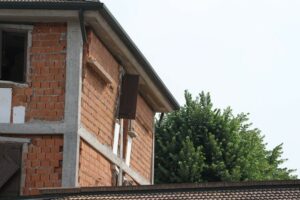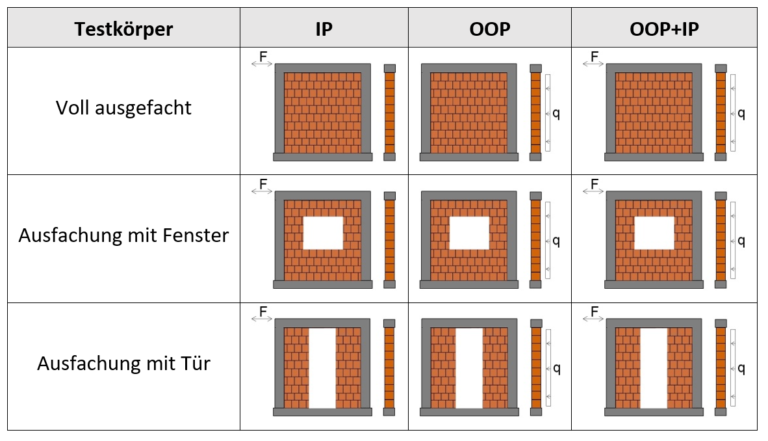| Project title: | Behaviour of reinforced concrete frames with decoupled masonry inclinations and openings under seismic influences |
| Sponsors: | German Academic Exchange Service (DAAD)Do ctoral Programme in Germany, Funding Programme: 57440921 |
| Partners: | RWTH Aachen Un iversityCenter for Wind and Earthquake Engineering P rof. Dr.-Ing. Christoph Butenweg Univ.-Prof. Dr.-Ing. Sven Klinkel M. Sc. Aleksa Milija university of Belgrade – Faculty of Civil Engineering Chair of Engineering Mechanics and Theory of Structures Dr.Marko Marinkovic, Assistant Professor |
| Project manager: | Prof. Dr.-Ing. Christoph Butenweg Tel: +49 (0) 241 – 60 09 53 16 0 butenweg@lbb.rwth-aachen.de |
| Project: | 2019 – 2022 |
Reinforced concrete frame constructions with masonry inclinations represent a large proportion of the building stock in earthquake-active regions worldwide. The inclinations are used both as an outer end of the building and for the subdivision inside the building. As non-supporting components, inclincipations in the sense of modern architectural requirements allow a flexible use of floor plan over the lifetime of the building. In addition, masonry inicurments offer very good properties in terms of sound insulation, fire protection and thermal insulation. However, the combination of reinforced concrete frames with high deformation capacities and, in comparison, very stiff masonry inflatings requires careful planning and execution of the masonry inflatings. Traditionally, the infusions are completely walled into the frame without gap dimensions, so that there are interactions between the frame and infusion. This leads to local damage at the wall level and can result in significant changes in the dynamic behavior of the entire building by activating the inflatings. This can also result in unfavorable torsional effects, which can initiate a building failure.
In addition, the insoles are loaded perennial to the plane by inertia forces, so that the connection of the insoles to the surrounding frame is of important importance. The connection must be designed in such a way that the forces persecurable to the wall are reliably derived even with larger frame deformations in the wall plane. This combined stressing of infill walls in and persecuting the wall plane has not been taken into account in practice, as the current earthquake standards consider and prove the stresses separately from each other. Also, pre-damage of the connections to the frame due to the cyclic nature of the seismic influences and the alternating stresses in and persecurable to the plane are not considered. In the event of an earthquake, this leads to major damage to buildings with a failure of entire indentation areas. Figure 1 shows, for example, the damage to buildings caused by the earthquakes in Emilia Romagna (2012).

Figure 1: Damage to infuse in Italy: Emilia Romagna (2012)
Intensive research has been carried out for decades on the behaviour of masonry infills under seismic stress, e.B. , , ,[2] ,[3] .[4] T[5]he[6] large number of research work and the repeated earthquake damage illustrate the difficulty of designating traditional masonry inclinations with full contact with the frame in an earthquake-proof manner. Therefore, various solution strategies for increasing the earthquake safety of inflamed masonry have been developed, which can be assigned to the three approaches shown in Figure 2. The first approach (Figure 2a) provides for an increase in the insinnation and its force-locking connection to the reinforced concrete frame. The second approach improves the deformation ability of the infill by arranging additional sliding planes (Figure 2b). The third approach is a decoupling of infusion and frame, so that the infusion does not force the frame deformations (Figure 2c)

Figure 2: Approaches to improve the seismic behaviour of masonry padding
In the context of the doctoral work financed by the DAAD, the behaviour of traditionally folded reinforced concrete frames with openings under loads in and perennial to the frame level is first examined in detail. The next step is to develop a decoupling system that allows the safe execution of folded reinforced concrete frames in earthquake areas with and without openings. The developments are carried out based on small component tests, cyclic thrust wall tests and numerical simulations. The planned experimental programme is summarised in Table 1. The effectiveness of the decoupling system is to be demonstrated by comparing test and simulation results on traditionally folded and decoupled reinforced concrete frames.

Table 1: Test program for cyclic wall tests
Literature
- Dazio A, Beyer K, Braune F, Fritsche S, Mittaz, X (2009). The Mw= 6.3 earthquake at L’Aquila on 6 April 2009. Report of the SGEB fact-finding mission of 15-18 2009.
- Al-Chaar G, Issa M, Sweeney S. (2002). Behavior of masonry-infilled nonductile reinforced concrete frames.Journal of Structural Engineering, 128(8), 1055-1063.
- Mehrabi AB, Benson Shing P, Schuller MP, Noland JL (1996). Experimental evaluation of masonry-infilled RC frames.Journal of Structural Engineering, 122(3), 228-237.
- Hak, S., Morandi, P., & Magenes, G. (2017). Prediction of inter-storey drifts for regular RC structures with masonry infills based on bare frame modelling.Bulletin of Earthquake Engineering, 1-29.
- Furtado, A., Rodrigues, H., A. (2015). Modelling of masonry infill walls participation in the seismic behavior of RC buildings using OpenSees.International Journal of Advanced Structural Engineering (IJASE), 7(2), 117-127.
- Butenweg, C., Meyer, U., Fehling, E.: EU project INSYSME: Innovative techniques for earthquake-proof inflating walls made of brickwork in reinforced concrete frame structures, masonry, volume 18, No. 2, pp. 78 – 81, 2014.
